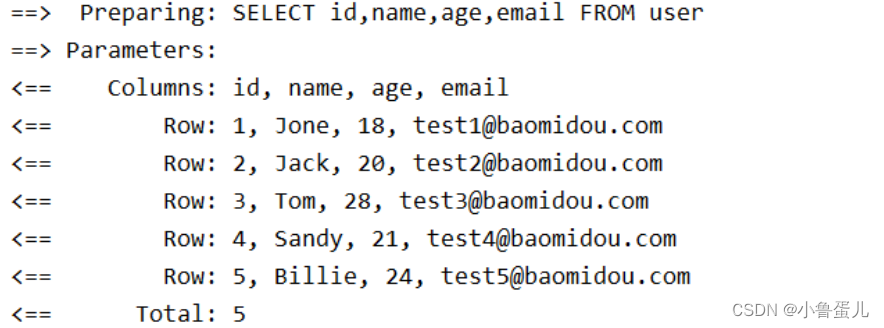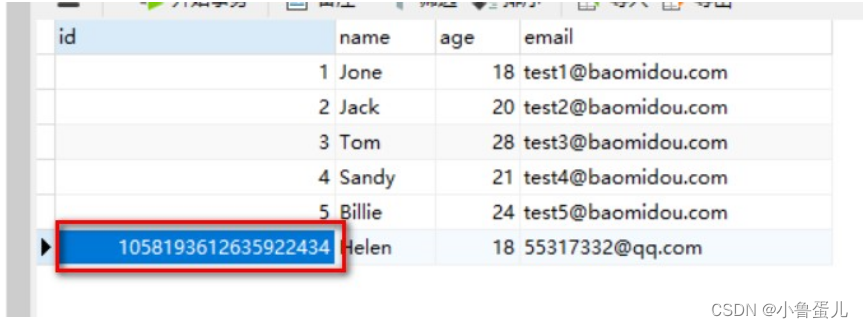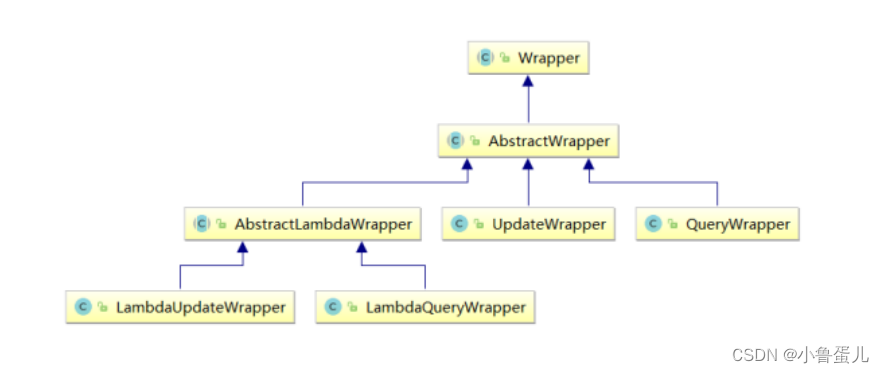一、MyBatis-Plus简介
1、简介
MyBatis-Plus(简称 MP)是一个 MyBatis的增强工具,在 MyBatis 的基础上只做增强不做改变,为简化开发、提高效率而生。
愿景
我们的愿景是成为 MyBatis 最好的搭档,就像魂斗罗中的 1P、2P,基友搭配,效率翻倍。

2、特性
无侵入:只做增强不做改变,引入它不会对现有工程产生影响,如丝般顺滑
损耗小:启动即会自动注入基本 CURD,性能基本无损耗,直接面向对象操作
强大的 CRUD 操作:内置通用 Mapper、通用 Service,仅仅通过少量配置即可实现单表大部分
CRUD 操作,更有强大的条件构造器,满足各类使用需求
支持 Lambda 形式调用:通过 Lambda 表达式,方便的编写各类查询条件,无需再担心字段写错
支持主键自动生成:支持多达 4 种主键策略(内含分布式唯一 ID 生成器 - Sequence),可自由
配置,完美解决主键问题
支持 ActiveRecord 模式:支持 ActiveRecord 形式调用,实体类只需继承 Model 类即可进行强
大的 CRUD 操作
支持自定义全局通用操作:支持全局通用方法注入( Write once, use anywhere )
内置代码生成器:采用代码或者 Maven 插件可快速生成 Mapper 、 Model 、 Service 、
Controller 层代码,支持模板引擎,更有超多自定义配置等您来使用
内置分页插件:基于 MyBatis 物理分页,开发者无需关心具体操作,配置好插件之后,写分页等
同于普通 List 查询
分页插件支持多种数据库:支持 MySQL、MariaDB、Oracle、DB2、H2、HSQL、SQLite、
Postgre、SQLServer 等多种数据库
内置性能分析插件:可输出 SQL 语句以及其执行时间,建议开发测试时启用该功能,能快速揪出
慢查询
内置全局拦截插件:提供全表 delete 、 update 操作智能分析阻断,也可自定义拦截规则,预防
误操作
二、入门案例
1、创建数据库及表
1)创建表
DROP TABLE IF EXISTS user;
CREATE TABLE user
(
id BIGINT(20) NOT NULL COMMENT '主键ID',
name VARCHAR(30) NULL DEFAULT NULL COMMENT '姓名',
age INT(11) NULL DEFAULT NULL COMMENT '年龄',
email VARCHAR(50) NULL DEFAULT NULL COMMENT '邮箱',
PRIMARY KEY (id)
);2)添加数据
INSERT INTO user (id, name, age, email) VALUES
(1, 'Jone', 18, 'test1@baomidou.com'),
(2, 'Jack', 20, 'test2@baomidou.com'),
(3, 'Tom', 28, 'test3@baomidou.com'),
(4, 'Sandy', 21, 'test4@baomidou.com'),
(5, 'Billie', 24, 'test5@baomidou.com');2、创建Spring Boot工程
1)初始化工程
使用 Spring Initializr 快速初始化一个 Spring Boot 工程
2)引入依赖
<dependencies>
<dependency>
<groupId>org.springframework.boot</groupId>
<artifactId>spring-boot-starter</artifactId>
</dependency>
<dependency>
<groupId>org.springframework.boot</groupId>
<artifactId>spring-boot-starter-test</artifactId>
<scope>test</scope>
<exclusions>
<exclusion>
<groupId>org.junit.vintage</groupId>
<artifactId>junit-vintage-engine</artifactId>
</exclusion>
</exclusions>
</dependency>
<!--mybatis-plus-->
<dependency>
<groupId>com.baomidou</groupId>
<artifactId>mybatis-plus-boot-starter</artifactId>
<version>3.0.5</version>
</dependency>
<!--mysql-->
<dependency>
<groupId>mysql</groupId>
<artifactId>mysql-connector-java</artifactId>
</dependency>
<!--lombok用来简化实体类-->
<dependency>
<groupId>org.projectlombok</groupId>
<artifactId>lombok</artifactId>
</dependency>
</dependencies>注意:引入
MyBatis-Plus之后请不要再次引入MyBatis以及MyBatis-Spring,以避免因版本差异导致的问题。
3)配置application.yml
spring:
datasource:
# 配置连接数据库信息
driver-class-name: com.mysql.jdbc.Driver
username: root
password: 12345
url: jdbc:mysql://localhost:3306/mybatis_plus?characterEncoding=utf-8&useSSL=false注意:
1、驱动类driver-class-name
spring boot 2.0(内置jdbc5驱动),驱动类使用:
driver-class-name: com.mysql.jdbc.Driver
spring boot 2.1及以上(内置jdbc8驱动),驱动类使用:
driver-class-name: com.mysql.cj.jdbc.Driver
否则运行测试用例的时候会有 WARN 信息
2、连接地址url
MySQL5.7版本的url:
jdbc:mysql://localhost:3306/mybatis_plus?characterEncoding=utf-8&useSSL=false
MySQL8.0版本的url:
jdbc:mysql://localhost:3306/mybatis_plus?
serverTimezone=GMT%2B8&characterEncoding=utf-8&useSSL=false
否则运行测试用例报告如下错误:
java.sql.SQLException: The server time zone value 'Öйú±ê׼ʱ¼ä' is unrecognized or
represents more
3、编写代码
1)启动类
Spring Boot启动类中添加@MapperScan注解,扫描mapper包
@SpringBootApplication
@MapperScan("com.atguigu.mybatisplus.mapper")
public class MybatisPlusApplication {
public static void main(String[] args) {
SpringApplication.run(MybatisPlusApplication.class, args);
}
}
2)添加实体
若实体类中的属性使用的是驼峰命名风格,而表中的字段使用的是下划线命名风格
例如实体类属性isDeleted,表中字isdeleted,此时MyBatis-Plus会自动将下划线命名风格转化为驼峰命名风格
在开发的过程中,我们经常遇到以上的问题,即实体类所对应的表都有固定的前缀,例如t_或tbl_,此时,可以使用MyBatis-Plus提供的全局配置,为实体类所对应的表名设置默认的前缀,那么就不需要在每个实体类上通过@TableName标识实体类对应的表。
mybatis-plus:
global-config:
db-config:
# 配置MyBatis-Plus操作表的默认前缀
table-prefix: t_@Data
public class User {
private Long id;
private String name;
private Integer age;
private String email;
}3)添加mapper
BaseMapper是MyBatis-Plus提供的模板mapper,其中包含了基本的CRUD方法,泛型为操作的
实体类型
public interface UserMapper extends BaseMapper<User> {
}4)测试
@RunWith(SpringRunner.class)
@SpringBootTest
public class MybatisPlusApplicationTests {
@Autowired
private UserMapper userMapper;
@Test
public void testSelectList() {
System.out.println(("----- selectAll method test ------"));
//UserMapper 中的 selectList() 方法的参数为 MP 内置的条件封装器 Wrapper
//所以不填写就是无任何条件
List<User> users = userMapper.selectList(null);
users.forEach(System.out::println);
}
}注意:
IDEA在 userMapper 处报错,因为找不到注入的对象,因为类是动态创建的,但是程序可以正确的执行。
为了避免报错,可以在 dao 层 的接口上添加 @Repository 注解
结果:

5)添加日志
在application.yml中配置日志输出
# 配置MyBatis日志
mybatis-plus:
configuration:
log-impl: org.apache.ibatis.logging.stdout.StdOutImpl
三、基本CRUD
1、BaseMapper
MyBatis-Plus中的基本CRUD在内置的BaseMapper中都已得到了实现,我们可以直接使用,接口如下:
public interface BaseMapper<T> extends Mapper<T> {
/**
* 插入一条记录
*
* @param entity 实体对象
*/
int insert(T entity);
/**
* 根据 ID 删除
*
* @param id 主键ID
*/
int deleteById(Serializable id);
/**
* 根据 columnMap 条件,删除记录
*
* @param columnMap 表字段 map 对象
*/
int deleteByMap(@Param(Constants.COLUMN_MAP) Map<String, Object> columnMap);
/**
* 根据 entity 条件,删除记录
*
* @param queryWrapper 实体对象封装操作类(可以为 null,里面的 entity 用于生成 where 语句)
*/
int delete(@Param(Constants.WRAPPER) Wrapper<T> queryWrapper);
/**
* 删除(根据ID 批量删除)
*
* @param idList 主键ID列表(不能为 null 以及 empty)
*/
int deleteBatchIds(@Param(Constants.COLLECTION) Collection<? extends Serializable> idList);
/**
* 根据 ID 修改
*
* @param entity 实体对象
*/
int updateById(@Param(Constants.ENTITY) T entity);
/**
* 根据 whereEntity 条件,更新记录
*
* @param entity 实体对象 (set 条件值,可以为 null)
* @param updateWrapper 实体对象封装操作类(可以为 null,里面的 entity 用于生成 where 语句)
*/
int update(@Param(Constants.ENTITY) T entity, @Param(Constants.WRAPPER) Wrapper<T> updateWrapper);
/**
* 根据 ID 查询
*
* @param id 主键ID
*/
T selectById(Serializable id);
/**
* 查询(根据ID 批量查询)
*
* @param idList 主键ID列表(不能为 null 以及 empty)
*/
List<T> selectBatchIds(@Param(Constants.COLLECTION) Collection<? extends Serializable> idList);
/**
* 查询(根据 columnMap 条件)
*
* @param columnMap 表字段 map 对象
*/
List<T> selectByMap(@Param(Constants.COLUMN_MAP) Map<String, Object> columnMap);
/**
* 根据 entity 条件,查询一条记录
*
* @param queryWrapper 实体对象封装操作类(可以为 null)
*/
T selectOne(@Param(Constants.WRAPPER) Wrapper<T> queryWrapper);
/**
* 根据 Wrapper 条件,查询总记录数
*
* @param queryWrapper 实体对象封装操作类(可以为 null)
*/
Integer selectCount(@Param(Constants.WRAPPER) Wrapper<T> queryWrapper);
/**
* 根据 entity 条件,查询全部记录
*
* @param queryWrapper 实体对象封装操作类(可以为 null)
*/
List<T> selectList(@Param(Constants.WRAPPER) Wrapper<T> queryWrapper);
/**
* 根据 Wrapper 条件,查询全部记录
*
* @param queryWrapper 实体对象封装操作类(可以为 null)
*/
List<Map<String, Object>> selectMaps(@Param(Constants.WRAPPER) Wrapper<T> queryWrapper);
/**
* 根据 Wrapper 条件,查询全部记录
* <p>注意: 只返回第一个字段的值</p>
*
* @param queryWrapper 实体对象封装操作类(可以为 null)
*/
List<Object> selectObjs(@Param(Constants.WRAPPER) Wrapper<T> queryWrapper);
/**
* 根据 entity 条件,查询全部记录(并翻页)
*
* @param page 分页查询条件(可以为 RowBounds.DEFAULT)
* @param queryWrapper 实体对象封装操作类(可以为 null)
*/
<E extends IPage<T>> E selectPage(E page, @Param(Constants.WRAPPER) Wrapper<T> queryWrapper);
/**
* 根据 Wrapper 条件,查询全部记录(并翻页)
*
* @param page 分页查询条件
* @param queryWrapper 实体对象封装操作类
*/
<E extends IPage<Map<String, Object>>> E selectMapsPage(E page, @Param(Constants.WRAPPER) Wrapper<T> queryWrapper);
}
2、insert
1)插入操作
@RunWith(SpringRunner.class)
@SpringBootTest
public class CRUDTests {
@Autowired
private UserMapper userMapper;
@Test
public void testInsert(){
User user = new User();
user.setName("Helen");
user.setAge(18);
user.setEmail("55317332@qq.com");
int result = userMapper.insert(user);
System.out.println(result); //影响的行数
System.out.println(user); //id自动回填
}
}注意:数据库插入id值默认为:全局唯一id

2)主键策略
MyBatis-Plus默认的主键策略是:ID_WORKER 全局唯一ID
参考资料:分布式系统唯一ID生成方案汇总:分布式系统唯一ID生成方案汇总 - nick hao - 博客园
自增策略
要想主键自增需要配置如下主键策略
- 需要在创建数据表的时候设置主键自增
- 实体字段中配置 @TableId(type = IdType.AUTO)
@TableId(type = IdType.AUTO)
private Long id;要想影响所有实体的配置,可以设置全局主键配置
#全局设置主键生成策略
mybatis-plus.global-config.db-config.id-type=auto其它主键策略:分析 IdType 源码可知
@Getter
public enum IdType {
/**
* 数据库ID自增
*/
AUTO(0),
/**
* 该类型为未设置主键类型
*/
NONE(1),
/**
* 用户输入ID
* 该类型可以通过自己注册自动填充插件进行填充
*/
INPUT(2),
/* 以下3种类型、只有当插入对象ID 为空,才自动填充。 */
/**
* 全局唯一ID (idWorker)
*/
ID_WORKER(3),
/**
* 全局唯一ID (UUID)
*/
UUID(4),
/**
* 字符串全局唯一ID (idWorker 的字符串表示)
*/
ID_WORKER_STR(5);
private int key;
IdType(int key) {
this.key = key;
}
}3、update
1)根据Id更新操作
@Test
public void testUpdateById(){
User user = new User();
user.setId(1L);
user.setAge(28);
int result = userMapper.updateById(user);
System.out.println(result);
}2)自动填充
项目中经常会遇到一些数据,每次都使用相同的方式填充,例如记录的创建时间,更新时间等。
我们可以使用MyBatis Plus的自动填充功能,完成这些字段的赋值工作:
1. 数据库表中添加自动填充字段
在User表中添加datetime类型的新的字段 create_time、update_time
2. 实体上添加注解
@Data
public class User {
......
@TableField(fill = FieldFill.INSERT)
private Date createTime;
@TableField(fill = FieldFill.INSERT_UPDATE)
private Date updateTime;
}3.实现元对象处理器接口
注意:不要忘记添加 @Component 注解
@Component
public class MyMetaObjectHandler implements MetaObjectHandler {
private static final Logger LOGGER = LoggerFactory.getLogger(MyMetaObjectHandler.class);
@Override
public void insertFill(MetaObject metaObject) {
LOGGER.info("start insert fill ....");
this.setFieldValByName("createTime", new Date(), metaObject);
this.setFieldValByName("updateTime", new Date(), metaObject);
}
@Override
public void updateFill(MetaObject metaObject) {
LOGGER.info("start update fill ....");
this.setFieldValByName("updateTime", new Date(), metaObject);
}
}3)乐观锁
主要适用场景:当要更新一条记录的时候,希望这条记录没有被别人更新,也就是说实现线程安全的数据更新
乐观锁实现方式:
- 取出记录时,获取当前version
- 更新时,带上这个version
- 执行更新时, set version = newVersion where version = oldVersion
- 如果version不对,就更新失败
1. 数据库中添加version字段
ALTER TABLE `user` ADD COLUMN `version` INT2. 实体类添加version字段
@Version
@TableField(fill = FieldFill.INSERT)
private Integer version;3. 元对象处理器接口添加version的insert默认值
@Override
public void insertFill(MetaObject metaObject) {
......
this.setFieldValByName("version", 1, metaObject);
}特别说明:
- 支持的数据类型只有 int,Integer,long,Long,Date,Timestamp,LocalDateTime
- 整数类型下
newVersion = oldVersion + 1 newVersion会回写到entity中- 仅支持
updateById(id)与update(entity, wrapper)方法 - 在
update(entity, wrapper)方法下,wrapper不能复用!!!
@EnableTransactionManagement
@Configuration
@MapperScan("com.atguigu.mybatis_plus.mapper")
public class MybatisPlusConfig {
/**
* 乐观锁插件
*/
@Bean
public OptimisticLockerInterceptor optimisticLockerInterceptor() {
return new OptimisticLockerInterceptor();
}
}5.测试乐观锁可以修改成功
测试后分析打印的sql语句,将version的数值进行了加1操作
/**
* 测试 乐观锁插件
*/
@Test
public void testOptimisticLocker() {
//查询
User user = userMapper.selectById(1L);
//修改数据
user.setName("Helen Yao");
user.setEmail("helen@qq.com");
//执行更新
userMapper.updateById(user);
}6. 测试乐观锁修改失败
/**
* 测试乐观锁插件 失败
*/
@Test
public void testOptimisticLockerFail() {
//查询
User user = userMapper.selectById(1L);
//修改数据
user.setName("Helen Yao1");
user.setEmail("helen@qq.com1");
//模拟取出数据后,数据库中version实际数据比取出的值大,即已被其它线程修改并更新了version
user.setVersion(user.getVersion() - 1);
//执行更新
userMapper.updateById(user);
}4、select
1)根据id查询记录
@Test
public void testSelectById(){
User user = userMapper.selectById(1L);
System.out.println(user);
}2)通过多个id批量查询
完成了动态sql的foreach的功能
@Test
public void testSelectBatchIds(){
List<User> users = userMapper.selectBatchIds(Arrays.asList(1, 2, 3));
users.forEach(System.out::println);
}3)简单的条件查询
通过map封装查询条件
@Test
public void testSelectByMap(){
HashMap<String, Object> map = new HashMap<>();
map.put("name", "Helen");
map.put("age", 18);
List<User> users = userMapper.selectByMap(map);
users.forEach(System.out::println);
}注意:map中的key对应的是数据库中的列名。例如数据库user_id,实体类是userId,这时map的key需要填写user_id
5、分页
MyBatis Plus自带分页插件,只要简单的配置即可实现分页功能
1. 创建配置类
/**
* 分页插件
*/
@Bean
public PaginationInterceptor paginationInterceptor() {
return new PaginationInterceptor();
}@Test
public void testSelectPage() {
Page<User> page = new Page<>(1,5);
userMapper.selectPage(page, null);
page.getRecords().forEach(System.out::println);
System.out.println(page.getCurrent());
System.out.println(page.getPages());
System.out.println(page.getSize());
System.out.println(page.getTotal());
System.out.println(page.hasNext());
System.out.println(page.hasPrevious());
}控制台sql语句打印:
SELECT id,name,age,email,create_time,update_time FROM user LIMIT 0,5 3. 测试selectMapsPage分页:结果集是Map
@Test
public void testSelectMapsPage() {
Page<User> page = new Page<>(1, 5);
IPage<Map<String, Object>> mapIPage = userMapper.selectMapsPage(page, null);
//注意:此行必须使用 mapIPage 获取记录列表,否则会有数据类型转换错误
mapIPage.getRecords().forEach(System.out::println);
System.out.println(page.getCurrent());
System.out.println(page.getPages());
System.out.println(page.getSize());
System.out.println(page.getTotal());
System.out.println(page.hasNext());
System.out.println(page.hasPrevious());
}6、delete
1)根据id删除记录
@Test
public void testDeleteById(){
int result = userMapper.deleteById(8L);
System.out.println(result);
}2)批量删除
@Test
public void testDeleteBatchIds() {
int result = userMapper.deleteBatchIds(Arrays.asList(8, 9, 10));
System.out.println(result);
}3)简单的条件查询删除
@Test
public void testDeleteByMap() {
HashMap<String, Object> map = new HashMap<>();
map.put("name", "Helen");
map.put("age", 18);
int result = userMapper.deleteByMap(map);
System.out.println(result);
}4)逻辑删除
- 物理删除:真实删除,将对应数据从数据库中删除,之后查询不到此条被删除数据
- 逻辑删除:假删除,将对应数据中代表是否被删除字段状态修改为“被删除状态”,之后在数据库中仍旧能看到此条数据记录
1. 数据库中添加 deleted字段
ALTER TABLE `user` ADD COLUMN `deleted` boolean2. 实体类添加deleted 字段
并加上 @TableLogic 注解 和 @TableField(fill = FieldFill.INSERT) 注解
@TableLogic
@TableField(fill = FieldFill.INSERT)
private Integer deleted;3. 元对象处理器接口添加deleted的insert默认值
@Override
public void insertFill(MetaObject metaObject) {
......
this.setFieldValByName("deleted", 0, metaObject);
}4. application.properties 加入配置
此为默认值,如果你的默认值和mp默认的一样,该配置可无
mybatis-plus.global-config.db-config.logic-delete-value=1
mybatis-plus.global-config.db-config.logic-not-delete-value=05. 在 MybatisPlusConfig 中注册 Bean
@Bean
public ISqlInjector sqlInjector() {
return new LogicSqlInjector();
}6. 测试逻辑删除
- 测试后发现,数据并没有被删除,deleted字段的值由0变成了1
- 测试后分析打印的sql语句,是一条update
- 注意:被删除数据的deleted 字段的值必须是 0,才能被选取出来执行逻辑删除的操作
/**
* 测试 逻辑删除
*/
@Test
public void testLogicDelete() {
int result = userMapper.deleteById(1L);
System.out.println(result);
}7. 测试逻辑删除后的查询
MyBatis Plus中查询操作也会自动添加逻辑删除字段的判断
/**
* 测试 逻辑删除后的查询:
* 不包括被逻辑删除的记录
*/
@Test
public void testLogicDeleteSelect() {
User user = new User();
List<User> users = userMapper.selectList(null);
users.forEach(System.out::println);
}测试后分析打印的sql语句,包含 WHERE deleted=0
SELECT id,name,age,email,create_time,update_time,deleted FROM user WHERE deleted=0五、性能分析
性能分析拦截器,用于输出每条 SQL 语句及其执行时间
SQL 性能执行分析,开发环境使用,超过指定时间,停止运行。有助于发现问题
1、配置插件
1)参数说明
参数:maxTime: SQL 执行最大时长,超过自动停止运行,有助于发现问题。
参数:format: SQL是否格式化,默认false。
2)在 MybatisPlusConfig 中配置
/**
* SQL 执行性能分析插件
* 开发环境使用,线上不推荐。 maxTime 指的是 sql 最大执行时长
*/
@Bean
@Profile({"dev","test"})// 设置 dev test 环境开启
public PerformanceInterceptor performanceInterceptor() {
PerformanceInterceptor performanceInterceptor = new PerformanceInterceptor();
performanceInterceptor.setMaxTime(100);//ms,超过此处设置的ms则sql不执行
performanceInterceptor.setFormat(true);
return performanceInterceptor;
}3)Spring Boot 中设置dev环境
#环境设置:dev、test、prod
spring.profiles.active=dev可以针对各环境新建不同的配置文件application-dev.properties、application-test.properties、application-prod.properties
也可以自定义环境名称:如test1、test2
2、测试
1)常规测试
/**
* 测试 性能分析插件
*/
@Test
public void testPerformance() {
User user = new User();
user.setName("我是Helen");
user.setEmail("helen@sina.com");
user.setAge(18);
userMapper.insert(user);
}
2)将maxTime 改小之后再次进行测试
performanceInterceptor.setMaxTime(5);//ms,超过此处设置的ms不执行如果执行时间过长,则抛出异常:The SQL execution time is too large,
输出:

六、通用Service
说明:
1、通用 Service CRUD 封装IService接口,进一步封装 CRUD 采用
get 查询单行 remove 删除 list 查询集合 page 分页 前缀命名方式区分 Mapper 层避免混淆,
2、泛型 T 为任意实体对象
3、建议如果存在自定义通用 Service 方法的可能,请创建自己的 IBaseService 继承
Mybatis-Plus 提供的基类
1)IService
MyBatis-Plus中有一个接口 IService和其实现类 ServiceImpl,封装了常见的业务层逻辑
详情查看源码IService和ServiceImpl
2)创建Service接口和实现类
UserService继承IService模板提供的基础功能
public interface UserService extends IService<User> {
}ServiceImpl实现了IService,提供了IService中基础功能的实现,若ServiceImpl无法满足业务需求,则可以使用自定的UserService定义方法,并在实现类中实现
@Service
public class UserServiceImpl extends ServiceImpl<UserMapper, User> implements UserService {
}3)测试查询记录数
@Autowired
private UserService userService;
@Test
public void testGetCount(){
long count = userService.count();
System.out.println("总记录数:" + count);
}4)测试批量插入
SQL长度有限制,海量数据插入单条SQL无法实行,因此MP将批量插入放在了通用Service中实现,而不是通用Mapper
@Test
public void testSaveBatch(){
ArrayList<User> users = new ArrayList<>();
for (int i = 0; i < 5; i++) {
User user = new User();
user.setName("ybc" + i);
user.setAge(20 + i);
users.add(user);
}
//SQL:INSERT INTO t_user ( username, age ) VALUES ( ?, ? )
userService.saveBatch(users);
}七、条件构造器和常用接口
1、wapper介绍

- Wrapper : 条件构造抽象类,最顶端父类
- AbstractWrapper : 用于查询条件封装,生成 sql 的 where 条件
- QueryWrapper : 查询条件封装
- UpdateWrapper : Update 条件封装
- AbstractLambdaWrapper : 使用Lambda 语法
- LambdaQueryWrapper :用于Lambda语法使用的查询Wrapper
- LambdaUpdateWrapper : Lambda 更新封装Wrapper
2、QueryWrapper
1)组装查询条件
查询用户名包含a,年龄在20到30之间,并且邮箱不为null的用户信息
SELECT id,username AS name,age,email,is_deleted FROM t_user WHERE
is_deleted=0 AND (username LIKE ? AND age BETWEEN ? AND ? AND email IS NOT NULL)@Test
public void test01(){
QueryWrapper<User> queryWrapper = new QueryWrapper<>();
queryWrapper.like("username", "a")
.between("age", 20, 30)
.isNotNull("email");
List<User> list = userMapper.selectList(queryWrapper);
list.forEach(System.out::println);
}2)组装排序条件
按年龄降序查询用户,如果年龄相同则按id升序排列
SELECT id,username AS name,age,email,is_deleted FROM t_user WHERE
is_deleted=0 ORDER BY age DESC,id ASC@Test
public void test02(){
QueryWrapper<User> queryWrapper = new QueryWrapper<>();
queryWrapper
.orderByDesc("age")
.orderByAsc("id");
List<User> users = userMapper.selectList(queryWrapper);
users.forEach(System.out::println);
}3)组装删除条件
删除email为空的用户
DELETE FROM t_user WHERE (email IS NULL)@Test
public void test03(){
QueryWrapper<User> queryWrapper = new QueryWrapper<>();
queryWrapper.isNull("email");
//条件构造器也可以构建删除语句的条件
int result = userMapper.delete(queryWrapper);
System.out.println("受影响的行数:" + result);
}4)条件的优先级
将(年龄大于20并且用户名中包含有a)或邮箱为null的用户信息修改
UPDATE t_user SET age=?, email=? WHERE (username LIKE ? AND age > ? OR
email IS NULL)@Test
public void test04() {
QueryWrapper<User> queryWrapper = new QueryWrapper<>();
queryWrapper
.like("username", "a")
.gt("age", 20)
.or()
.isNull("email");
User user = new User();
user.setAge(18);
user.setEmail("user@atguigu.com");
int result = userMapper.update(user, queryWrapper);
System.out.println("受影响的行数:" + result);
}lambda表达式内的逻辑优先运算
@Test
public void test04() {
QueryWrapper<User> queryWrapper = new QueryWrapper<>();
queryWrapper
.like("username", "a")
.and(i -> i.gt("age", 20).or().isNull("email"));
User user = new User();
user.setAge(18);
user.setEmail("user@atguigu.com");
int result = userMapper.update(user, queryWrapper);
System.out.println("受影响的行数:" + result);
}5)组装select子句
查询用户信息的username和age字段
@Test
public void test05() {
QueryWrapper<User> queryWrapper = new QueryWrapper<>();
queryWrapper.select("username", "age");
//selectMaps()返回Map集合列表,通常配合select()使用,避免User对象中没有被查询到的列值
为null
List<Map<String, Object>> maps = userMapper.selectMaps(queryWrapper);
maps.forEach(System.out::println);
}6)实现子查询
查询id小于等于3的用户信息
SELECT id,username AS name,age,email,is_deleted FROM t_user WHERE (id IN
(select id from t_user where id <= 3))@Test
public void test06() {
QueryWrapper<User> queryWrapper = new QueryWrapper<>();
queryWrapper.inSql("id", "select id from t_user where id <= 3");
List<User> list = userMapper.selectList(queryWrapper);
list.forEach(System.out::println);
}3、UpdateWrapper
将(年龄大于20或邮箱为null)并且用户名中包含有a的用户信息修改
UPDATE t_user SET username=?, age=?,email=? WHERE (username LIKE ? AND
(age > ? OR email IS NULL))@Test
public void test07() {
//组装set子句以及修改条件
UpdateWrapper<User> updateWrapper = new UpdateWrapper<>();
//lambda表达式内的逻辑优先运算
updateWrapper
.set("age", 18)
.set("email", "user@atguigu.com")
.like("name", "a")
.and(i -> i.gt("age", 20).or().isNull("email"));
//这里必须要创建User对象,否则无法应用自动填充。如果没有自动填充,可以设置为null
//User user = new User();
//user.setName("张三");
//int result = userMapper.update(user, updateWrapper);
int result = userMapper.update(null, updateWrapper);
System.out.println(result);
}4、condition
在真正开发的过程中,组装条件是常见的功能,而这些条件数据来源于用户输入,是可选的,因
此我们在组装这些条件时,必须先判断用户是否选择了这些条件,若选择则需要组装该条件,若
没有选择则一定不能组装,以免影响SQL执行的结果。
思路一:
@Test
public void test08() {
//定义查询条件,有可能为null(用户未输入或未选择)
String username = null;
Integer ageBegin = 10;
Integer ageEnd = 24;
QueryWrapper<User> queryWrapper = new QueryWrapper<>();
if(StringUtils.isNotBlank(username)){
queryWrapper.like("username","a");
}
if(ageBegin != null){
queryWrapper.ge("age", ageBegin);
}
if(ageEnd != null){
queryWrapper.le("age", ageEnd);
}
//SELECT id,username AS name,age,email,is_deleted FROM t_user WHERE (age >=? AND age <= ?)
List<User> users = userMapper.selectList(queryWrapper);
users.forEach(System.out::println);
}思路二:
上面的实现方案没有问题,但是代码比较复杂,我们可以使用带condition参数的重载方法构建查
询条件,简化代码的编写
@Test
public void test08UseCondition() {
//定义查询条件,有可能为null(用户未输入或未选择)
String username = null;
Integer ageBegin = 10;
Integer ageEnd = 24;
QueryWrapper<User> queryWrapper = new QueryWrapper<>();
queryWrapper
.like(StringUtils.isNotBlank(username), "username", "a")
.ge(ageBegin != null, "age", ageBegin)
.le(ageEnd != null, "age", ageEnd);
List<User> users = userMapper.selectList(queryWrapper);
users.forEach(System.out::println);
}5、LambdaQueryWrapper
@Test
public void test09() {
//定义查询条件,有可能为null(用户未输入)
String username = "a";
Integer ageBegin = 10;
Integer ageEnd = 24;
LambdaQueryWrapper<User> queryWrapper = new LambdaQueryWrapper<>();
//避免使用字符串表示字段,防止运行时错误
queryWrapper
.like(StringUtils.isNotBlank(username), User::getName, username)
.ge(ageBegin != null, User::getAge, ageBegin)
.le(ageEnd != null, User::getAge, ageEnd);
List<User> users = userMapper.selectList(queryWrapper);
users.forEach(System.out::println);
}6、LambdaUpdateWrapper
@Test
public void test10() {
//组装set子句
LambdaUpdateWrapper<User> updateWrapper = new LambdaUpdateWrapper<>();
updateWrapper
.set(User::getAge, 18)
.set(User::getEmail, "user@atguigu.com")
.like(User::getName, "a")
.and(i -> i.lt(User::getAge, 24).or().isNull(User::getEmail));
User user = new User();
int result = userMapper.update(user, updateWrapper);
System.out.println("受影响的行数:" + result);
}七、通用枚举
表中的有些字段值是固定的,例如性别(男或女),此时我们可以使用MyBatis-Plus的通用枚举
来实现
1)数据库表添加字段sex
2)创建通用枚举类型
@Getter
public enum SexEnum {
MALE(1, "男"),
FEMALE(2, "女");
@EnumValue
private Integer sex;
private String sexName;
SexEnum(Integer sex, String sexName) {
this.sex = sex;
this.sexName = sexName;
}
}3)配置扫描通用枚举
mybatis-plus:
# 配置扫描通用枚举
type-enums-package: com.atguigu.mybatisplus.enums4)测试
设置性别信息为枚举项,会将@EnumValue注解所标识的属性值存储到数据库
@Test
public void testSexEnum(){
User user = new User();
user.setName("john");
user.setAge(20);
user.setSex(SexEnum.MALE);
userMapper.insert(user);
}八、代码生成器
AutoGenerator 是 MyBatis-Plus 的代码生成器,通过 AutoGenerator 可以快速生成 Entity、
Mapper、Mapper XML、Service、Controller 等各个模块的代码,极大的提升了开发效率。
1、引入依赖
<dependency>
<groupId>com.baomidou</groupId>
<artifactId>mybatis-plus-generator</artifactId>
<version>3.4.1</version>
</dependency>
<dependency>
<groupId>org.freemarker</groupId>
<artifactId>freemarker</artifactId>
<version>2.3.31</version>
</dependency>2、快速生成
public class AutoCode {
public static void main(String[] args) {
// 需要构建一个 代码自动生成器 对象
AutoGenerator mpg = new AutoGenerator();
// 配置策略
// 1、全局配置
GlobalConfig gc = new GlobalConfig();
//当前项目的路径
String projectPath = System.getProperty("user.dir");
gc.setOutputDir(projectPath+"/src/main/java");
gc.setAuthor("xiaoludan");
gc.setOpen(false);
gc.setFileOverride(false); // 是否覆盖
gc.setServiceName("%sService"); // 去Service的I前缀
gc.setIdType(IdType.ID_WORKER);
gc.setDateType(DateType.ONLY_DATE);
gc.setSwagger2(true);
mpg.setGlobalConfig(gc);
//2、设置数据源
DataSourceConfig dsc = new DataSourceConfig();
dsc.setUrl("jdbc:mysql://localhost:3306/mybatis_plus?characterEncoding=utf-8&useSSL=false");
dsc.setDriverName("com.mysql.cj.jdbc.Driver");
dsc.setUsername("root");
dsc.setPassword("12345");
dsc.setDbType(DbType.MYSQL);
mpg.setDataSource(dsc);
//3、包的配置
PackageConfig pc = new PackageConfig();
pc.setModuleName("blog");
pc.setParent("com.atguigu");
pc.setEntity("entity");
pc.setMapper("mapper");
pc.setService("service");
pc.setController("controller");
mpg.setPackageInfo(pc);
//4、策略配置
StrategyConfig strategy = new StrategyConfig();
// 设置要映射的表名
strategy.setInclude("blog_tags","course","links","sys_settings","user_record");
trategy.setNaming(NamingStrategy.underline_to_camel);
strategy.setColumnNaming(NamingStrategy.underline_to_camel);
strategy.setEntityLombokModel(true); // 自动lombok;
strategy.setLogicDeleteFieldName("deleted");
// 自动填充配置
TableFill gmtCreate = new TableFill("cearte_time", FieldFill.INSERT);
TableFill gmtModified = new TableFill("update_time",
FieldFill.INSERT_UPDATE);
ArrayList<TableFill> tableFills = new ArrayList<>();
tableFills.add(create_time);
tableFills.add(update_time);
strategy.setTableFillList(tableFills);
//乐观锁
strategy.setVersionFieldName("version");
strategy.setRestControllerStyle(true);
strategy.setControllerMappingHyphenStyle(true);
mpg.setStrategy(strategy);
mpg.execute(); //执行
}
}九、多数据源
适用于多种场景:纯粹多库、 读写分离、 一主多从、 混合模式等
目前我们就来模拟一个纯粹多库的一个场景
场景说明:
我们创建两个库,分别为:mybatis_plus(以前的库不动)与mybatis_plus_1(新建),将
mybatis_plus库的product表移动到mybatis_plus_1库,这样每个库一张表,通过一个测试用例
分别获取用户数据与商品数据,如果获取到说明多库模拟成功
1、创建数据库及表
创建数据库mybatis_plus_1和表product
CREATE DATABASE `mybatis_plus_1`;
use `mybatis_plus_1`;
CREATE TABLE product
(
id BIGINT(20) NOT NULL COMMENT '主键ID',
name VARCHAR(30) NULL DEFAULT NULL COMMENT '商品名称',
price INT(11) DEFAULT 0 COMMENT '价格',
version INT(11) DEFAULT 0 COMMENT '乐观锁版本号',
PRIMARY KEY (id)
);添加测试数据
INSERT INTO product (id, NAME, price) VALUES (1, '外星人笔记本', 100);删除mybatis_plus库product表
use mybatis_plus;
DROP TABLE IF EXISTS product;2、引入依赖
<dependency>
<groupId>com.baomidou</groupId>
<artifactId>dynamic-datasource-spring-boot-starter</artifactId>
<version>3.5.0</version>
</dependency>3、配置多数据源
spring:
# 配置数据源信息
datasource:
dynamic:
# 设置默认的数据源或者数据源组,默认值即为master
primary: master
# 严格匹配数据源,默认false.true未匹配到指定数据源时抛异常,false使用默认数据源
strict: false
datasource:
master:
url: jdbc:mysql://localhost:3306/mybatis_plus?characterEncoding=utf-8&useSSL=false
driver-class-name: com.mysql.cj.jdbc.Driver
username: root
password: 123456
slave_1:
url: jdbc:mysql://localhost:3306/mybatis_plus_1?characterEncoding=utf-8&useSSL=false
driver-class-name: com.mysql.cj.jdbc.Driver
username: root
password: 1234564、创建用户service
public interface UserService extends IService<User> {
}@DS("master") //指定所操作的数据源
@Service
public class UserServiceImpl extends ServiceImpl<UserMapper, User> implements
UserService {
}5、创建商品service
public interface ProductService extends IService<Product> {
}@DS("slave_1")
@Service
public class ProductServiceImpl extends ServiceImpl<ProductMapper, Product>
implements ProductService {
}6、测试
@Autowired
private UserService userService;
@Autowired
private ProductService productService;
@Test
public void testDynamicDataSource(){
System.out.println(userService.getById(1L));
System.out.println(productService.getById(1L));
}结果:
1、都能顺利获取对象,则测试成功
2、如果我们实现读写分离,将写操作方法加上主库数据源,读操作方法加上从库数据源,自动切
换,是不是就能实现读写分离?























 500
500











 被折叠的 条评论
为什么被折叠?
被折叠的 条评论
为什么被折叠?










